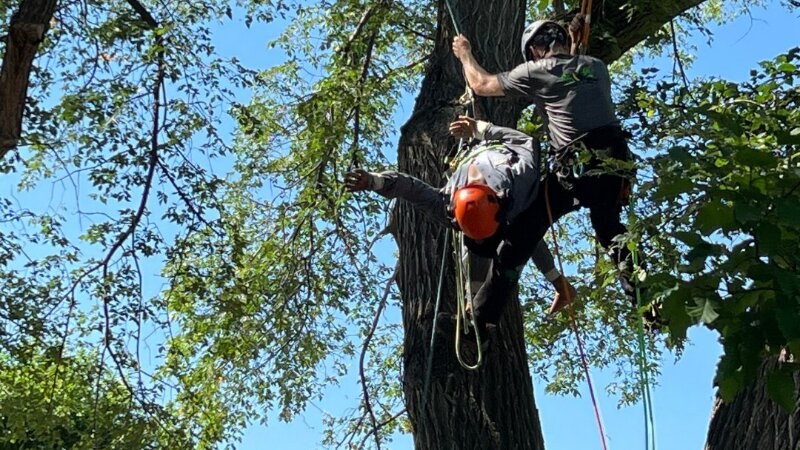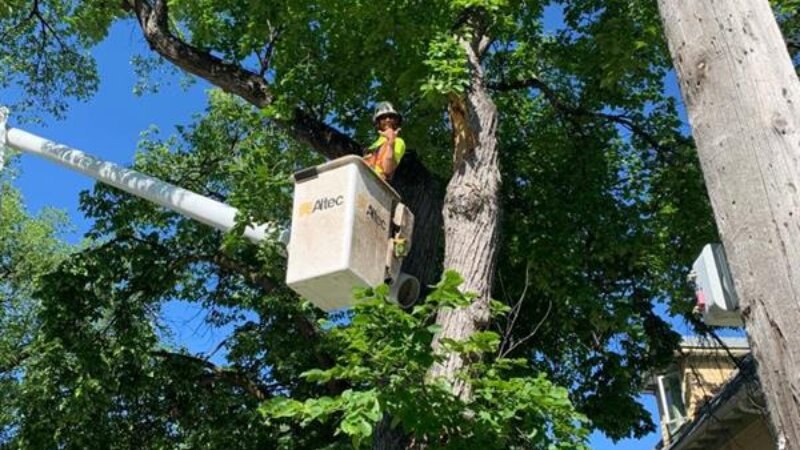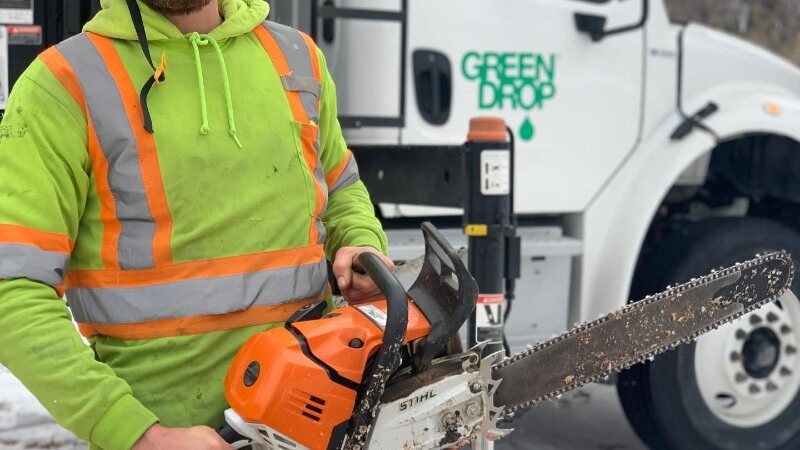Asking our Edmonton Arborists: What's the Difference Between Tree Trimming Vs. Pruning?
Reading time: 6 minutesTaking good care of your trees is essential for keeping them healthy and looking great. When done correctly, trimming and pruning your trees can help prevent pests, breakage, and disease. But what’s the difference between them?
We asked our arborists, and here’s what they had to say.

Tree Trimming
People often confuse the terms pruning and trimming or use them interchangeably. Though similar, tree trimming is less heavy-duty than pruning. Most experts focus on green shoots, weaker branches, or malformed areas when trimming.
Tree Pruning
Pruning a tree involves removing only the excess branches to help maintain a uniform size and shape and promote healthy growth. Regrowth is usually thicker and happens faster with good trimming techniques than if your trees stay untrimmed.
Crown Cleaning
Crown cleaning, on the other hand, means removing damaged, diseased, overgrown, or loose branches that are likely to cause issues later on. Depending on the tree, these changes may be minor or significant.
Understanding the Key Differences
The most significant difference between tree trimming and pruning is why you make the cuts. Trimming is usually done to enhance the natural beauty of trees, while pruning is primarily done for protection against pests and disease.
Tree Pruning Methods
If you’re pruning a tree, there are three primary ways to do so. The method you choose depends mainly on the tree and your desired results.
Crown Thinning
Crown thinning involves removing certain branches to reduce the overall density of the tree's foliage. This increases the penetration of sunlight and air and protects load-bearing limbs from becoming too heavy.
Crown Raising
Crown raising is done when a tree's branches are low to the ground, obstructing your view or limiting your ability to use an area. This is done slowly over time to reduce the amount of stress put on the tree at once.
Crown Reduction
Older trees are good candidates for crown reduction, a pruning technique that increases the number of lateral branches in a tree to help promote new growth. This also helps strengthen the tree's larger, more important branches.
Crown cleaning can also be done during any pruning service to remove problematic branches and help prevent future damage to the tree.

Tips & Methods to Use
Improper tree cutting can cause serious problems, whether you’re trimming, pruning, or even just removing a single branch. Here are some things we follow:
- We always use clean cutting tools.
- We’ll usually sanitize our tools between each cut to prevent the spread of disease.
- Trim or prune during the winter when trees are dormant.
- We calculate what we want to remove first and double-check it before cutting.
- Never remove more than 25% of a tree’s canopy in a single year.
- The idea is not to prune trees in the late summer or fall since their growth is most active.
- Avoid trimming or pruning trees that are close to powerlines or cables.
- If you’re taking this on yourself, stick to cutting small branches and leave the larger ones to the professionals.
When to Trim
Knowing when you should trim or prune is essential. Cutting your trees too much at the wrong time can undo all your hard work and put your tree at risk.
The best time for trimming trees in Edmonton is during the dormant season, anywhere between the first and last frosts. Trimming right before spring may be even better since new growth starts quickly and seals the open wounds faster. Plus, trimming in the winter allows you to see which branches you want to cut without all the foliage in the way.
When to Prune
Mature trees generally only need light pruning once every couple of years to remove dead or dying wood. However, young trees should be pruned more often to cultivate strong branch growth in your desired direction. There are also some specifics depending on the type of tree you have or if a storm comes through:
- Wait to prune flowering and fruit-bearing trees. It’s best to delay cutting until after their flowers have dropped.
- Avoid pruning elm and oak trees in the spring, summer, and early fall. This helps prevent the spread of disease and damaging insects like elm bark beetles.
- Consider waiting until foliage has emerged to prune sappy trees like walnuts, beech trees, birches, and Canada's beloved maples. This helps obscure "bleeding" after pruning, which is when sap oozes out of the wound.
- Prune-damaged limbs right after a storm. Waiting could put you at risk of property damage or injury since these limbs are weak and unpredictable.
Frequently Asked Questions (FAQs) About Tree Trimming and Pruning
How do I know if my tree needs trimming?
Some signs it's time to trim your trees include if they look misshapen, have overgrown branches, or have branches that crisscross over one another. You should also trim if your tree is very dense or has so much foliage that it prevents light from getting through to the inner branches.
How do I know if my tree needs to be pruned?
Indicators that your trees may need to be pruned include broken or dead branches, storm damage, cankers, or other signs of disease. Typically, a tree with large branches needing removal should be pruned instead of trimmed.
How much of my tree should I trim at one time?
Less is more when it comes to trimming a tree. It’s important never to remove more than 20% of your tree's entire canopy when trimming. In fact, 10% is even better and drastically reduces the overall stress on the tree. Too many cuts can stress a tree, making it slower to heal and more susceptible to disease.
How often should my trees be trimmed?
As a rule, trees only need trimming once every few years unless there’s a problem. Storm damage, disease, and pests could require frequent trimming or pruning. Fruit trees should be pruned as often as every year. Working with a professional ISA-certified arborist is a good idea for developing a custom tree care service plan for your specific needs.
Can I prune a young tree?
Newly planted trees shouldn’t be pruned until they are at least a few years old. Then structural pruning is recommended to help shape the tree in the manner in which you want it to grow. Pruning a baby tree too soon before it has well-established roots can put it at risk of premature damage or death.

How Green Drop’s Edmonton ISA-Certified Arborists Can Help
Our Edmonton arborists are passionate about healthy trees.
We provide comprehensive tree trimming and tree pruning services in other locations like Red Deer, Calgary, Regina, Saskatoon, and Winnipeg.
Get in touch today for a free estimate for beautiful trees that stand the test of time.

